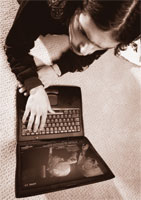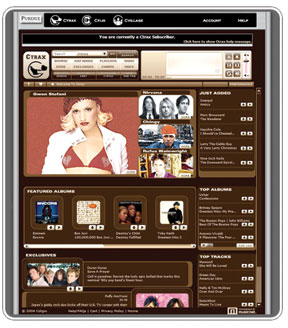Broadband Networking >> The 'Other' VoIP
 While colleges and universities rush to send voice over the internet protocol,
a select few are using broadband pipes to deliver something far more sophisticated.
While colleges and universities rush to send voice over the internet protocol,
a select few are using broadband pipes to deliver something far more sophisticated.
Television sets are a dying breed at Northwestern University
(IL). Walk the halls of the Bobb and McCullough residence halls on the north
end of the school’s suburban Chicago campus, and you’re likely to
find nary a one. Down at the other end, in the dorms at 1835 Hinman Avenue,
the boob tubes are just as scarce. Visitors to campus might like to think that
students ditched their TVs to focus on studying, but the truth is that NU students
have simply consolidated their devices, and now watch all of their favorite
programs via their personal computers.
Facilitated by a technology dubbed Video over the Internet Protocol (IP), this
social change has altered just about every aspect of dormitory recreation. Through
a broadband application from the vendor Video Furnace (www.videofurnace.com),
every student with a laptop or desktop computer and a network connection can
now access up to 24 channels of public and cable television, including MTV,
TNT, C-SPAN, and more. According to David Carr, director of Telecommunications
and Network Services, students only have to open a program to watch their favorite
shows.
“Video over IP just might be the hottest technology
of 2005— the next big thing in broadband for months to come.”
“What we’ve done is unique,” he says, explaining that NUTV,
the campus’s video-over-IP solution, has replaced traditional cable TV
services across campus. “Instead of putting coaxial cable into every single
dorm, we figured out how we could deliver cable television leveraging our existing
broadband data network.”
And talk about convergence: As colleges and universities rush to send voice
over the Internet, a handful of institutions are using their broadband pipes
to deliver video information as well. Leaders in this area are implementing
solutions similar to Northwestern’s hardware and software packages, which
enable students to watch cable television through the same interface they use
to write papers with Microsoft Word. Other schools, not yet sold on the idea
of eliminating coaxial cable all together, are turning to video over IP for
next-generation video conferencing to facilitate distance education.
These developments bring broadband networking to a whole new level, enabling
schools to carry voice, data, and video traffic together in one neat bundle.
On campuses with extensive wireless networks, the video-over-IP technology is
even more sophisticated, affording students total functionality without plugging
in to Ethernet ports at all. Still, the technology isn’t flawless; on
occasion, wireless networking has presented bandwidth challenges for those institutions
blazing these new trails. On the whole, though, video over IP just might be
the hottest technology of 2005—the next big thing in broadband for months
to come.
“IP networks provide a great deal of bandwidth at low cost,” said
Gerry Kaufhold, principal analyst with In-Stat/MDR (www.instat.com),
a market research firm that follows high-tech trends in a variety of industries.
“Corporate video services are already embracing IP infrastructures, and
[academia] will gradually move to IP [video] services, as well.”
Powered by Furnace
At Northwestern, the drive for a campus cable television system like NUTV began
in the early 1990s, and dragged on for nearly a decade before the school stumbled
upon Video Furnace. Touting its new Video Furnace IP Video System, the vendor
approached Carr in 2002 and convinced him to launch an 800-student trial delivering
four channels: C-SPAN, C-SPAN2, a campus calendar channel, and a channel of
programming in French. The trial was such a success that at the start of the
2003 school year, students all over campus were clamoring for the technology.
Carr responded as quickly as possible, over the next year investing roughly
$300,000 in discretionary IT funds on the hardware and software necessary to
make the system come to life. By this past September, the solution was available
to all 4,300 Ethernet ports in dormitories across the campus.
Today, NUTV boasts 24 channels: the original four, plus 20 individually licensed
channels from the largest local cable provider, Comcast (www.comcast.com).
Each of these channels is powered by a separate IP video server that captures
analog television signals directly from the coaxial cable feed, converts the
analog signals to digital, encapsulates them, encrypts them, attaches them to
IP packets, and multicasts them over the network using standard video protocols
such as MPEG-1, MPEG-2, and MPEG-4, for delivery over the broadband pipe. The
server technology, dubbed LiveFurnace, handles conversion and delivery in virtual
real time, meaning there is no recognizable delay between data on the Video
Furnace system and data coming straight off of the coaxial line. For students,
at least in terms of performance, there literally is no difference between the
two.
When students want to watch NUTV, they simply log on through OnGuide, a Java-enabled
Web portal, and click on the program they’d like to watch. To enable viewing,
each Video Furnace server delivers a 300-kilobyte, thin-client viewer as part
of every stream. The viewer, also known as the InStream Player, d'es not stay
on the student’s hard drive, and disappears after the session is closed
or terminated. The uniform and temporary nature of the viewer allows it to be
deployed in a variety of computing environments, including Windows, Macintosh,
and Linux. According to Video Furnace CEO Howard Weinzimmer, this feature also
gives Carr complete version and usage control, enabling NU to avoid overheads
associated with thick-client media applications, which can frequently top $100,000
per year.
“No other IP video solution allows computer users to enjoy a television-like
experience without the encumbrance of proprietary-installed and difficult-to-maintain
media players,” Weinzimmer brags, noting that the streaming technology
is optimized to minimize bandwidth usage as well. “Just when schools thought
their broadband networking applications couldn’t get any broader, we’re
here to offer something new.”
Northwestern students pay $100 each year for NUTV. At Dartmouth College
(NH), Video Furnace’s newest customer, the fee is rolled into a $15 monthly
fee for a trio of IP services: voice, data, and video. On the video side, Dartmouth
has partnered with local cable provider Adelphia (www.adelphia.com)
to deliver licensed access to 67 channels, including Turner Classic Movies,
the Cartoon Network, and the Sundance Channel, to name a few. With 67 LiveFurnace
servers on the back end, all Dartmouth students have to do to watch is plug
in to the network, fire up their computers, find the OnGuide, and log on. Just
like the system at Northwestern, the entire process occurs in virtual real time,
and rarely puts more than a dent in the school’s 1GB wired backbone.
Because Dartmouth offers an equally powerful wireless network, many students
access the Video Furnace IP Video System remotely, from their laptops. Generally,
the IP video system functions perfectly over the wireless environment, with
no lags in performance due to demands on bandwidth. Between peak viewing times
of 6 pm to 11 pm, S. Bradley Noblet, director of Technical Services, says that
high volume can present some interesting challenges in delivering maximum bandwidth
all of the time. To combat these challenges, Noblet says he’s deployed
dozens of wireless switches from Cisco (www.cisco.com)
to segment the campus into regions. Within this decentralized setup, Noblet
can load-balance video connections across multiple access points in a given
region, ensuring that demand in one particular corner of campus is never too
high.

[Photo above] In an institutional partnership program between Seton Hall’s
Stillman School of Business and Yeshiva Gedola Ohr Yisrael, GlowPoint video
over IP is helping rabbinical students get their MBAs remotely.
“I don’t have to have one access point delivering all of my video,”
he says. “If I’m making the effort to run this service over my broadband
network, I’m going to distribute the traffic as I would any other type
of traffic in a high-demand situation.”
Built with the Brick
Video Furnace isn’t the only vendor in the television video-over-IP marketplace;
in addition to Cisco’s fading IPTV solution, the other major alternative
in the space comes from VBrick Systems (www.vbrick.com),
which has been around since 1997. Termed EthernetV, from a back-end technical
perspective (save for different component names), VBrick’s offering works
much the same way as the Video Furnace system d'es. The main difference is in
the delivery: While Video Furnace customers watch IP television via an evanescent
thin-client viewer sent as part of the video stream, the VBrick system incorporates
Stream Player, a more sizable piece of software that users receive with the
video stream during the first download and must keep on their desktops in order
to decode the encrypted digital signals and watch.
Today, dozens of schools use EthernetV, including the University of
Massachusetts and the United States Military Academy at West
Point (NY). For small monthly licensing fees of $10 to $15 charged
directly to students, both of these schools offer more than 50 channels over
the Internet protocol; to watch, students simply log in through a Web portal,
click on the program they want, and enjoy. EthernetV also has been used overseas
by the military, particularly in Iraq. During last year’s Super Bowl,
for instance, US Army officials signed up for the VBrick service so that troops
with nothing more than a solid Internet connection could gather around a laptop,
kick back for the 3:30 am (local time) kickoff, and experience the Big Game
in the midst of the Middle East.
“Whether we’re working with an educational institution or troops
on the front lines, we deliver high-quality, DVD-quality video to any place
with an Internet connection,” claims Mike Savic, VBrick’s director
of marketing. “For us, it’s all about taking full advantage of the
technology.”
As Savic explains, however, the VBrick system is about more than just IP television.
Included in the $10,000 server price, each VBrick server boasts a separate technology
that enables customers to capture and broadcast live video from any Ethernet
port on campus. To take advantage of this feature, customers plug the VBrick
server into the network and string cables from the device’s FireWire and
S-Video ports to a standard digital video camera. As customers film events live,
the server encodes the digital video, attaches it to IP packets, and multicasts
them over the network using MPEG-2 and MPEG-4 protocols for delivery over the
broadband pipe. In recent years, schools have implemented this technology to
capture and broadcast a variety of live events. From there, with the help of
an additional (but purely optional) $15,000 Media Control Server, schools also
can archive video and offer programs for users in an on-demand environment—just
like Pay-Per-View, only free.
At the University of Arkansas for instance, school officials
broadcast football games live over IP, then make them available at any time.
At Case Western Reserve University (OH), the site of October’s
Vice Presidential debate, technologists beamed the event over the campus broadband
network to remote locations and attendees at VIP functions, then archived the
event for unedited and commercial-free viewing on demand. Finally, at Southeast
Kentucky Community and Technical College, IT employees have used the
technology to set up a new network environment dubbed the Kentucky Postsecondary
Education Network (KPEN), and soon will be using the technology to create a
weekly Webinar for Congressman Harold Rogers, chairman of the Subcommittee on
Homeland Security. According to Charley Simpson, director of Technology and
Telecommunications, Southeast students and other KPEN users can either watch
the Webinar live, or access it from an archive whenever they wish.
“The KPEN effort enables us to send MPEG-2 quality video between any
of our four remote campuses, and an entire network of public K-12 schools,”
says Simpson. “We’re reaching out to more students than we ever
thought we’d reach, and we’re doing it with technologies we never
thought we’d have, in ways we never dreamed of.”
Get to Know These Video-over-IP Vendors
Thinking about a move to video over IP? Head over to these
Web sites to check out product and service information.

On-demand IP-based music etc. is Cdigix’s sell.
Video Furnace (www.videofurnace.com)
The company claims it has developed the first true “enterprise edition” software-
controlled solution for converging live video to the desktop and other IP
devices, without requiring installed client side players.
VBrick Systems (www.vbrick.com)
This video-over-IP vendor was founded in 1997, and boasts the invention of
the MPEG Video Network Appliance.
Cdigix (www.cdigix.com)
Cdigix says it provides colleges and universities with a flexible IP-based
distribution platform for on-demand movies, TV programs, digital music, classic
and independent films, sports, educational materials, and more.
Radvision (www.radvision.com)
In business for over 10 years, Radvision provides “high quality, scalable,
and easy-to-use” products and technologies for IP video conferencing, video
telephony, and tools for the development of converged voice, video, and data
solutions over IP and 3G networks.
GlowPoint (www.glowpoint.com)
A more recent comer to the space, GlowPoint launched in 2000 as the first
broadcast quality IP-based video communications service provider.
Variations on a Theme
Not surprisingly, other vendors are moving quickly to meet VBrick’s
ability to broadcast live and on-demand video over the broadband pipe. Cdigix
(www.cdigix.com), a video
over IP company that also delivers music over the broadband pipe, offers Video
on-Demand (VoD) services that include feature films, television productions,
sports specials, short films, news productions, and other rich video content
programmed specifically for the interests of college students. Radvision (www.radvision.com),
an Israeli company with US headquarters in the Northeast, boasts yet another
alternative, combining live video, teleconferencing technology, and online archiving
to deliver a solution that essentially is video conferencing over IP.
“At Case Western, technologists beamed the vice
presidential debate over the campus network to remote sites, then archived it
for viewing on demand.”
The Radvision solution, dubbed viaIP, hinges upon a proprietary H.323 Enhanced
Communications Server, or ECS. This device, with hefty retails of $44,000 to
$99,000 depending on the size of a school, collects live data from a video camera,
encodes it, attaches it to IP packets, and interacts with a connection manager
called a Multipoint Control Unit (MCU), which sends the information out over
the school’s ISDN or broadband network.
On the other end, a user or central
terminal with eConf endpoint software from France Telecom receives the information,
decodes it, and displays it in a viewing panel on the user’s computer. Jim Christopoulos,
Radvision’s director of strategic accounts, says that most schools implement
the viaIP solution for distance education from one live video classroom to another.
“Distance learning is the bread-and-butter application of video over IP” he
says, adding that institutions such as New York University,
Oregon Health & Science University, and Ohio State
University currently use variations of viaIP. “In order to simulate
the in-person learning experience for students on either side of the camera,
you want the interaction to be as lifelike as possible, and that’s the environment
we create.”
GlowPoint (www.glowpoint.com),
another video-over-IP vendor specializing in live broadcasting for distance
education, takes a managed services approach. Under this model, instead of shelling
out upwards of $100,000 for a hardware and software-based IP videoconferencing
solution, for roughly $11,000 annually, academic customers lease a secure router
to establish a direct T1 connection back to GlowPoint’s New Jersey headquarters.
Customers then pay $499 per class per month, and have the ability to launch
an unlimited number of IP video conferences. When school officials are ready
to fire up a broadcast, they use a digital video camera to collect live video
images and send them back to GlowPoint through the router. According to CEO
David Trachtenberg, GlowPoint d'es the rest, provisioning the information alongside
IP packets, and transporting it on a secure Virtual Local Area Network (VLAN)
through another router at the intended destination, all over pre-existing broadband
connections.
Nowhere d'es this technology work better than at Seton Hall University
(NJ), where officials at the Stillman School of Business use it to offer a popular
part-time MBA program to rabbinical students at the Yeshiva Gedola Ohr
Yisrael academy (NY). Seton Hall professors teach MBA courses in a
special classroom equipped with digital video equipment and a direct, 45MB connection
out to the Internet. At the beginning of every class, technologists open a live
IP video connection to a similarly wired classroom at Yeshiva, where the students
gather around a computer screen to watch in real time. A camera in the classroom
at Yeshiva enables students there to interact with professors and classmates
back at Seton Hall, simulating the classroom experience as if students and professors
were working together at the same site. The result is seamless participation
from two divergent sites, 50 miles apart.
Since the program launched in September 2003, the setup has worked well for
both schools. For Yeshiva, video over IP has allowed about 20 students the opportunity
to study for their MBAs, a secular experience to complement their Talmudic studies
and give them more marketability when they are ready to graduate.
It also saves
the students hours of commuting time; although Seton Hall is just across the
Hudson River, traffic in the metropolitan New York area can turn travel between
the two schools into a three-hour trek daily. For Seton Hall, GlowPoint extends
the MBA program beyond the edges of the New Jersey campus, and importantly,
extends revenue as well: 75 percent of full tuition, per student. What’s
more, because the school used to spend $2 per minute on poor-quality video conferencing
calls over regular phone lines, Stillman Dean Karen Boroff maintains that GlowPoint’s
IP-based technology creates a huge cost savings for the business school, too.
“The technology has completely revolutionized our thinking and approach
to distance education,” she says, noting that the school plans to launch
another distance education relationship with a second Jewish seminary later
this month [January 2005]. “When you really start to explore some of the
benefits of video over IP, it’s amazing what you can do.”

